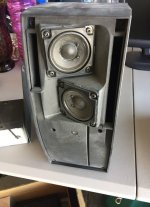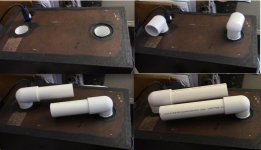Build a small front-loaded subwoofer cabinet. Cut holes for ports on both L/H and R/H sides. Link ports with tube. Cut "half-pipe" section in centre of tube so as cabinet is vented left and right.
If half-pipe cut-out is off-centre does this create ports tuned to different frequencies?
If half-pipe cut-out is off-centre does this create ports tuned to different frequencies?
Yes, because the tuning frequency has to do with the mass of air in the enclosed (full-round) section of pipe. The real question is how much off center? If only a little, will it matter?
You are describing two different port lengths with a mechanical brace between the two.
You are describing two different port lengths with a mechanical brace between the two.
The higher tuned port would negate the effect of the lower tuned port.
Then why is this not the case in any multi-port system?
Yes, because the tuning frequency has to do with the mass of air in the enclosed (full-round) section of pipe. The real question is how much off center? If only a little, will it matter?
You are describing two different port lengths with a mechanical brace between the two.
I only understand the basics. However, at some point doesn't the effective port length become variable? e.g. 10" total port length, 6" to the right (30Hz) 4" to the left (50Hz). In the absence of any signal at 30Hz isn't the effective length of the port now the full 10" - (70Hz)?
Feel free to be condescending, treat me like a four-year-old. But wouldn't the variable air pressure affect perceived resistance?
Seriously, I don't know about this stuff. I won't get but butt-hurt if you call me out as an idiot on the WWW. I was studying the design of the BOSE 302 . . .
O.K. I have to assume you know how a bass reflex enclosure (aka Helmholtz resonator) works. 🙂
A single driver in a single enclosure can only have one reflex tuning frequency.
A port resonates at a frequency determined by the elasticity of the air in the enclosure and the mass of the air in the port. Change the length of the port and you change the mass of air within the port and hence its resonant frequency.
Think of a mass suspended from a spring - change the mass and you change the frequency of its vibration.
In a traditionaly tuned ported cabinet, the resonant frequency of the port is chosen to match the resonant frequency of the loudspeaker cone so that reflex action may take place.
Including a second port tuned to a different frequency in the same enclosure would upset the intended reflex action.
In a twin ported enclosure, the two ports must be of the same length to hold identical air masses and ensure a single resonant frequency.
A single driver in a single enclosure can only have one reflex tuning frequency.
A port resonates at a frequency determined by the elasticity of the air in the enclosure and the mass of the air in the port. Change the length of the port and you change the mass of air within the port and hence its resonant frequency.
Think of a mass suspended from a spring - change the mass and you change the frequency of its vibration.
In a traditionaly tuned ported cabinet, the resonant frequency of the port is chosen to match the resonant frequency of the loudspeaker cone so that reflex action may take place.
Including a second port tuned to a different frequency in the same enclosure would upset the intended reflex action.
In a twin ported enclosure, the two ports must be of the same length to hold identical air masses and ensure a single resonant frequency.
Share the design with me if possible.I was studying the design of the BOSE 302 . . .
Do you mean the attached Bose 302?
Attachments
Galu,The higher tuned port would negate the effect of the lower tuned port.
"Negate" is probably not the correct term.
The Fb (frequency of the box/port tuning) using two different length ports of the same diameter will be in between the the Fb of two ports of the shorter or longer length.
As an example, using a 15.9 liter (.5618 cubic feet) net cabinet, various tunings (Fb) are roughly:
76 Hz with no elbows (two 1.5” PVC schedule 40 plumbing pipe couplings)
62 Hz with 1 elbow
60 Hz with 2 elbows
48 Hz with two elbows and one 5"(past elbow)
44 Hz with elbows and two 5" (past elbow)
40 Hz with elbows and one 5" & one 8" (past elbow)
35 Hz with elbows two 8" (past elbow)
Though nominally (named) 1.5 inch, the interior dimensions of the schedule 40 pipe couplings, elbows, and pipes are not actually 1.5", so there is some variation in the cross-sectional area in the above parts used to create each port length. The Fb in each case was determined by examination of the cone excursion minima using each port combination.
Hot Rod 8” 2-Way PA/Studio Monitor
Art
Attachments
Last edited:
There is not such a thing as a "tuned port" working all by itself and having "its own resonance" for God´s sake!!!!
Unless you think of port tube as an "organ pipe" ... which is not the case here.
Bass reflex resonance comes from the (whole) mass of the air moving in the port(s) , emphasis on "(s)" , and inside air elasticity or compliance.
The full system exhibits resonance, not each element on its own.
Which would be equivalent to say that a capacitor defines resonance, or an inductor, each on its own.
The whole tank will have a resonant frequency, same with Bass Reflex cabinet.
It simplifies analysis by having 2 equal ports, but that´s not an indispensable condition, 2 different ports will combine into a single, equivalent one, same as 2 capacitors or 2 inductors will.
Unless you think of port tube as an "organ pipe" ... which is not the case here.
Bass reflex resonance comes from the (whole) mass of the air moving in the port(s) , emphasis on "(s)" , and inside air elasticity or compliance.
The full system exhibits resonance, not each element on its own.
Which would be equivalent to say that a capacitor defines resonance, or an inductor, each on its own.
The whole tank will have a resonant frequency, same with Bass Reflex cabinet.
It simplifies analysis by having 2 equal ports, but that´s not an indispensable condition, 2 different ports will combine into a single, equivalent one, same as 2 capacitors or 2 inductors will.
Hi weltersys!
You appear to be giving me the 'elbow'! 🙂
I did read that the higher frequency port will 'short out' the lower frequency port.
So you are using the changing sum of the two different port air masses to provide you with multiple resonant frequencies to suit different conditions of use?
I'm not sure why Surtsey would want a static version of your arrangement though.
You appear to be giving me the 'elbow'! 🙂
I did read that the higher frequency port will 'short out' the lower frequency port.
So you are using the changing sum of the two different port air masses to provide you with multiple resonant frequencies to suit different conditions of use?
I'm not sure why Surtsey would want a static version of your arrangement though.
Hi JM!. . .for God´s sake!!!!
Yes I get you! (Our posts overlapped.)
Here's what you said in a thread from 2013 and it makes sense to me. 🙂
You basically have a single "capacitor" (the air elasticity inside the box) and many "inductors" (the air mass in the different tubes).
That system will have a *single* resonant frequency, coming from the single "capacitance" and the *single* "inductance" , coming from the combination of all the individual ones.
Galu,So you are using the changing sum of the two different port air masses to provide you with multiple resonant frequencies to suit different conditions of use?
The different tunings can be used depending on application for the "full range" cabinets- the higher tunings are useful when a sub is used below, the lower tunings when used at lower volume levels without a sub woofer.
Note that the same "air mass" can result in different tunings- a large diameter short port will result in higher Fb than a smaller diameter, longer port with exactly the same air mass.
Art
- Home
- Loudspeakers
- Subwoofers
- Can this be calculated? Is it a pointless exercise?

